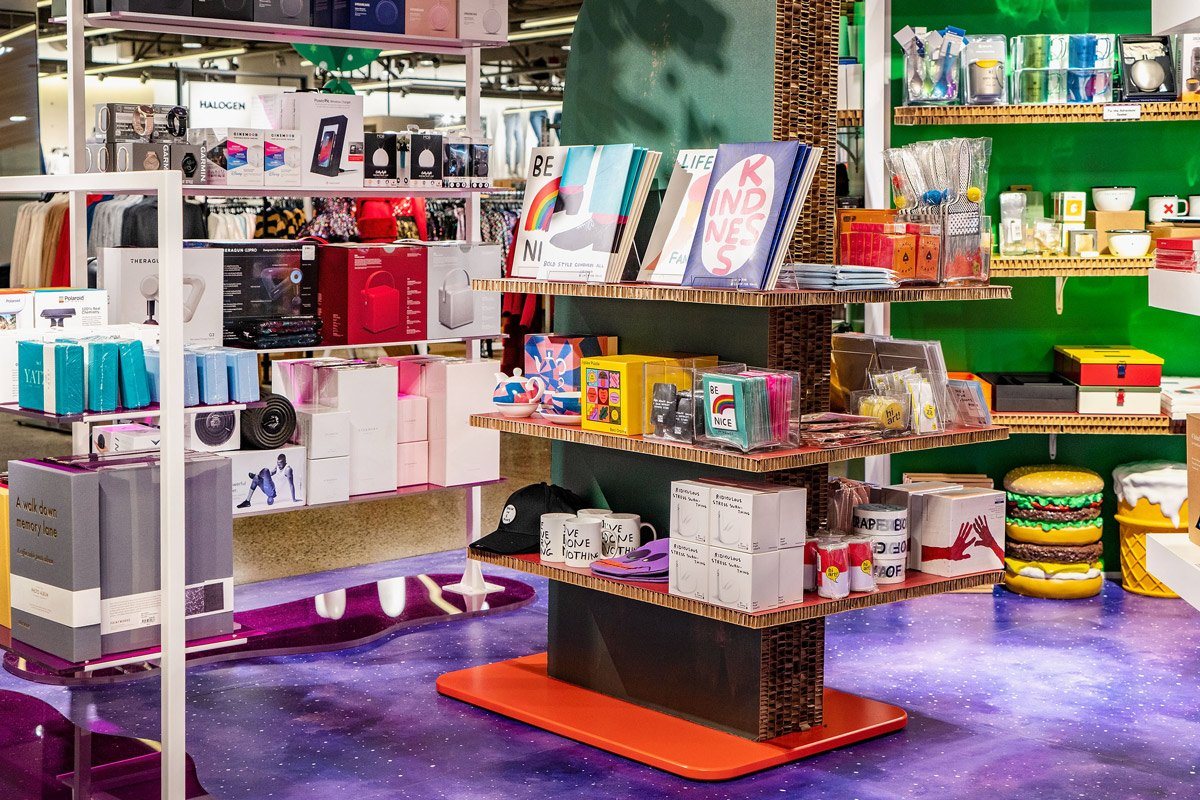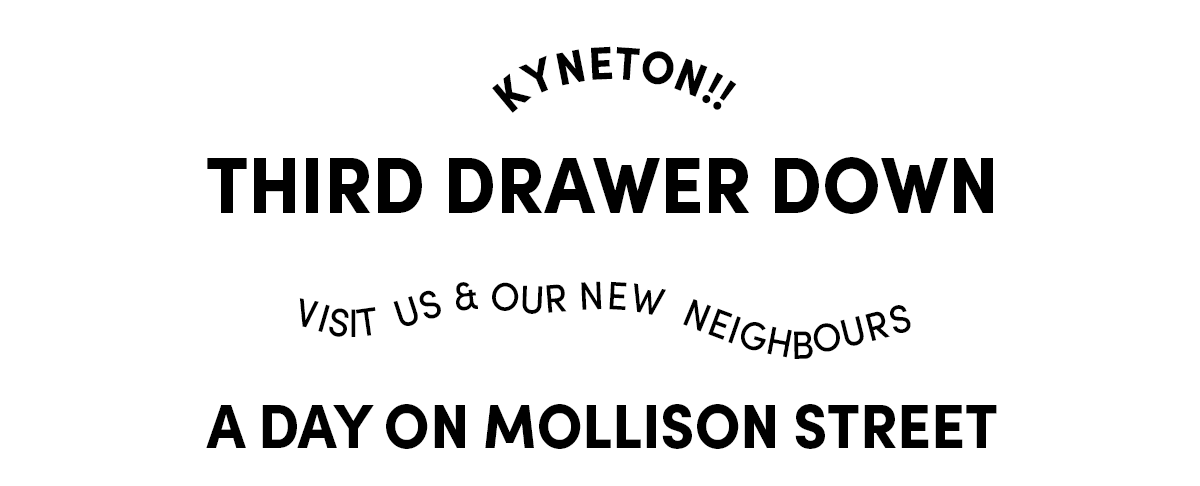摄影 + 布景设计 + 第三个抽屉!见见梅尔和萨姆。
·
·


这个概念被称为“平衡法案”,请告诉我们为什么您想通过 Third Drawer Down 来研究这个特定的视觉创意?
我之所以想到这个概念,是因为我认为 Third Drawer Down 的整体理念是关于平衡的;看似不可能的事物组合在一起——既有实物也有创意——对我来说,这就是这家商店的决定性特征。我的意思是,你还能在哪里找到一件可以用来擦干盘子的严肃艺术品?我喜欢这个想法,它很有趣。
我之所以想到这个概念,是因为我认为 Third Drawer Down 的整体理念是关于平衡的;看似不可能的事物组合在一起——既有实物也有创意——对我来说,这就是这家商店的决定性特征。我的意思是,你还能在哪里找到一件可以用来擦干盘子的严肃艺术品?我喜欢这个想法,它很有趣。
您的背景是造型设计,然而,您自然而然地转向了布景设计和造型设计的完美结合……您如何向人们描述您的工作?
哦,天哪,太难了!我想最好的解释方式是快速介绍一下我的背景,实际上这是一种学科的折衷组合。我想这一切都源于我在大学期间学习广告学。
大学三年让我学会了广告界创造性解决问题的方法——创造性思维和分析性思维的结合。我喜欢这个过程,现在仍然喜欢。但问题是,那三年也让我意识到,在广告公司工作(我唯一有资格从事的工作)可能并不适合我。
因此,我决定将创意沟通技能与我对制作物品的热爱结合起来,这自然而然地将我引向了视觉营销,以及其中的展示设计。视觉营销行业的伟大之处在于,你最终会投入到工作的范围和多样性中:设计展示、阐述概念、采购道具、为营销单元和固定装置制定详细计划、研究饰面和材料、用手锯和钻头爬梯子(但可能不会同时使用这两种工具!)、设计窗户贴花和标牌……真的,还有很长的路要走!视觉营销人员之所以优秀,是因为他们采用务实的动手方法,优先考虑进步而不是完美;学习曲线很陡峭。
从此,一扇通往造型设计的大门打开了。我满怀热情地走进那扇门,而那套不同的技能则在背后跟随着我。
所以,现在我从事的项目多种多样,既有真正以商业产品为中心的工作,比如为 Target 目录设计静物图像;也有为时尚拍摄设计抽象场景;还有创意指导和道具造型;还有一些零散的展示设计工作。这真是一份大杂烩,非常适合我。
《平衡法》主要使用纸质道具,能否向我们介绍一下你是如何开始使用纸张以及其中涉及的过程?
建造这些雕塑?
事实上,我经常摆弄纸质结构——研究如何用一张纸制作 3D 物体的精确过程确实符合我一丝不苟的天性;我甚至可以说我觉得它很放松。
因此,对于这组作品,我认为将这些经过严格测量、无缝、彩色的形状与我根本没有测量、规划或打磨过的用木屑手工制作的其他结构结合起来可能会很有趣。换句话说,在完美主义(我的默认设置)和更自发的“剪切粘贴”方法(超出了我的舒适区)之间取得平衡!
您认为什么人或什么事影响了您的风格?
这个问题很难回答。我选择“什么”:也就是说,我可能倾向于在以非常抽象的大局模式思考事物(展览 a:我对这个问题的回答!)和以最小、最具体的细节思考事物之间摇摆不定,这些细节与材料、方法和构造有关。而且,事实上,我对介于这两种模式之间的所有思维模式都感到厌烦(坦率地说,我不太擅长)!
您最想寻找创作灵感的四个地方?
我知道这听起来有些陈词滥调,但我真的认为灵感可以来自任何地方。我认为这只是保持开放的心态,看看什么可能是你的简报的答案。广告界的老把戏是“看看窗外……现在把你看到的任何东西都变成问题的答案”。
此外,我想说我更喜欢从我的专业之外寻找灵感。我倾向于关注时尚趋势,因为它们变化如此之快,我认为它们是衡量设计和文化所有领域涓滴效应/泡沫效应的一个很好的指标。我也从播客中听到其他创意人士的声音中获得了很多灵感——我最喜欢的是黛比·米尔曼的《设计很重要》。最后,在旧货店/五金店/回收店找到的非传统材料往往能激发最好的想法!
对新兴创意人士有什么建议吗?
嗯,我认为我能给出的最好建议是联系那些你欣赏其作品的人,并请求他们提供帮助。如果你因为感到害怕或其他原因而拖延联系这些人(我曾经有过这种感觉)——无论如何,请这样做!我认为绝大多数有创造力的人都具有情商和谦逊,能够记住当你刚开始尝试时有多么困难,并且如果可以的话,他们会很乐意帮助你。
拍摄中最喜欢的产品?
我一直是 David Shrigley 的粉丝,但我不得不说,我认为Del Kathryn Barton Highway is a Disco Scarf非常漂亮……我不想与它分开!

交给 SAM!新晋摄影师请继续阅读!
是什么吸引您与 Melanie 和 Third Drawer Down 合作开展这个项目?
认识梅尔很久了,我们一直想一起做点什么。这似乎是个利用光线、形状和古怪事物来取乐的好机会。
您从事摄影师工作多久了?前往 Rufus & Cooper 的旅程是怎样的?
我从事摄影师工作已经 10 多年了,这段经历非常棒。虽然付出了很多努力,但只有几天我真正把它当成工作。这就是你要做的事,我热爱我所做的事情。经营自己的事业有时会让人筋疲力尽,但当你知道自己已经做到了,回报就会更加甜蜜。
整天待在镜头后面最喜欢的部分是什么?
与不同的人一起工作和合作,创造出色的图像,同时享受其中的乐趣。有人曾经将创意专业人士描述为“解决问题并让人们快乐”。我认为这很贴切,我喜欢解决问题并让人们快乐!
梦想项目?
在国际范围内做我所做的事情。
对新兴摄影师有什么建议吗?
你所做的一切都会受到关注。从你作为助理的工作方式到你为客户付出的额外努力。从你偷工减料到你给别人的感觉。总是尽你所能,人们就会想再次与你合作,并向其他人推荐你。
您最常去的四个地方来寻找创作灵感?
音乐视频
其他摄影师的作品
品特斯特
艺术画廊
拍摄中最喜欢的物品?
David Shrigley先生的任何作品
我们非常喜欢和他们两个一起完成这个项目。合作的乐趣真是太有意义了!如果你错过了最终的图片,你可以在这里看到它们。



